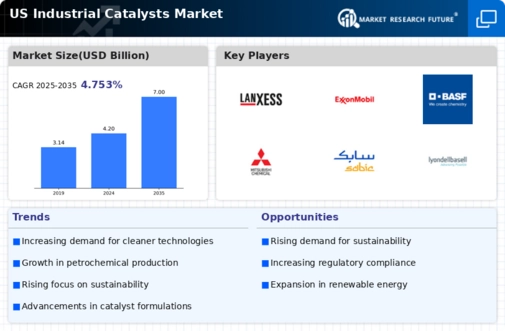The industrial catalysts market is characterized by a dynamic competitive landscape, driven by the increasing demand for efficient and sustainable chemical processes. Key players such as BASF (US), Honeywell (US), and W.R. Grace (US) are at the forefront, leveraging innovation and strategic partnerships to enhance their market positions. BASF (US) focuses on developing advanced catalyst technologies that improve process efficiency, while Honeywell (US) emphasizes digital transformation and automation in catalyst applications. W.R. Grace (US) is actively pursuing mergers and acquisitions to expand its product portfolio and market reach, indicating a trend towards consolidation in the sector.
The market structure appears moderately fragmented, with several players competing for market share. Companies are increasingly localizing manufacturing and optimizing supply chains to enhance operational efficiency and reduce costs. This strategy not only improves responsiveness to market demands but also strengthens their competitive edge. The collective influence of these key players shapes the market dynamics, as they vie for leadership through innovation and strategic positioning.
In November 2025, BASF (US) announced a partnership with a leading technology firm to develop AI-driven catalyst solutions aimed at reducing emissions in industrial processes. This strategic move underscores BASF's commitment to sustainability and positions the company as a leader in environmentally friendly catalyst technologies. The integration of AI is likely to enhance operational efficiencies and provide a competitive advantage in a market increasingly focused on sustainability.
In October 2025, Honeywell (US) launched a new line of catalysts designed specifically for the petrochemical industry, which aims to improve yield and reduce energy consumption. This product introduction reflects Honeywell's strategy to innovate within niche markets, thereby solidifying its position as a key player in the industrial catalysts sector. The focus on energy efficiency aligns with broader industry trends towards sustainability and cost reduction.
In September 2025, W.R. Grace (US) completed the acquisition of a smaller catalyst manufacturer, enhancing its capabilities in specialty catalysts. This acquisition is indicative of W.R. Grace's strategy to broaden its product offerings and strengthen its market presence. By integrating new technologies and expertise, the company is likely to enhance its competitive positioning and respond more effectively to evolving customer needs.
As of December 2025, the competitive trends in the industrial catalysts market are increasingly defined by digitalization, sustainability, and the integration of advanced technologies such as AI. Strategic alliances are becoming more prevalent, as companies seek to leverage complementary strengths to drive innovation. The shift from price-based competition to a focus on technological advancement and supply chain reliability is evident, suggesting that future competitive differentiation will hinge on the ability to innovate and adapt to changing market demands.






















Leave a Comment